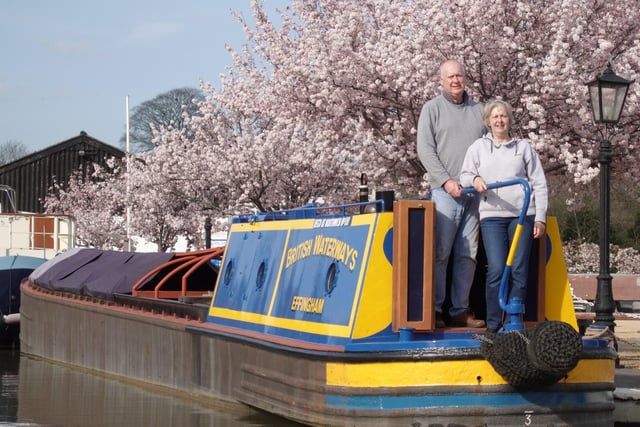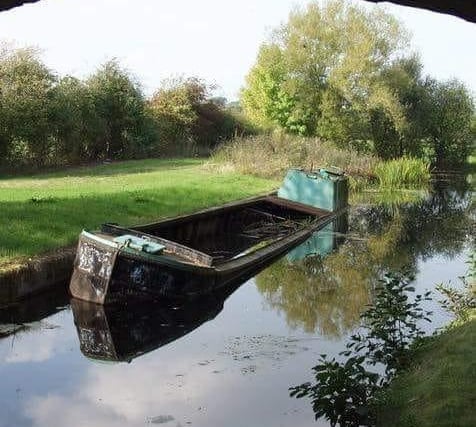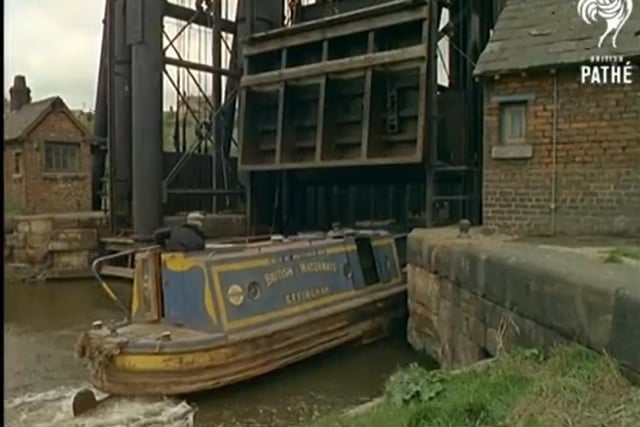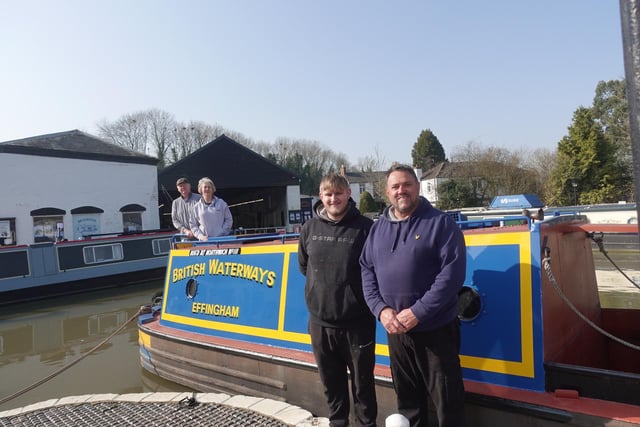New life has been breathed into a narrowboat ahead of a historic rally in Braunston next month.
Effingham owners Keith and Gill Astley are looking forward to showing off their boat at Braunston Historic Narrowboat Rally.
The boat has had a full repaint, restoring it to its original 1959 British Waterways livery. The work was carried out by father and son boat-painters Dave and Aaron Bishop in Braunston Marina’s famous 1792 ‘Little Dry Dock’ – used by generations of famous narrowboat painters, including the legendary Frank Nurser, and later Ron Hough, who taught Dave his trade.
The Effingham is now back on its mooring in the marina, allowing four weeks for the paint to harden up before applying the cherry-on-the- cake, a replica vinyl transfer of the British Waterways logo, which was applied to all the boats in its fleet, as they came up for repaints or in the case of new boats, such as the Admiral Class, as they were built in the late 1950s. There are original unused transfers still out there somewhere, somewhat faded and hard to get, but an enterprising firm in Scotland now makes replicas and the Astleys have acquired a pair of them ready to go.
The Astleys acquired the Effingham in December 2019, and moved it to their home mooring at Braunston Marina. Their purchase turned out to be shortly before the Covid- 19 epidemic hit in the Spring of 2020 – and they have since been very restricted in the opportunities to use the boat, and more importantly to continue the great restoration programme carried out by the two previous owners – whose endeavours the Astleys willingly acknowledge.
Tim Coghlan director of Braunston Marina said: “The Effingham story is a fascinating one – a tale of the triumph of reality over false hope. The canals and waterways were nationalised on January 1, 1948 - and with then in time the major canal carriers.
"This was by the post-WWII Labour government as it sought to bring all the major forms of transport into public ownership, as part of a massive programme of nationalisation.”
The new canal-controlling body came to known in abbreviated form as British Waterways, which name appeared on their canal fleet. By that time, for many observers it was a strange move, as the the writing was on the wall for canal transportation.
The IWA had been founded just over a year before, in 1946, in order to try and save them, as they collapsed under near-bankrupt private ownership. As the canal historian David Blagrove commented, whatever one’s views are on the merits of post-WWII nationalisation generally, in the case of the canals, it actually unintentionally saved them.
Tim added: “Soon British Waterways realised the enormity of the task it had taken on, and became hell-bent on closing all but the major canals and reducing the size of the huge fleets of carriers it had acquired – principally from the Grand Union Canal Carrying Company and Fellows, Morton and Clayton. The surviving fleet had its old livery changed, as the boats that were to be retained came in for repaints.
"A new simple livery of yellow cabin sides with pale blue coach lines was devised, much to the boatmen and the IWA’s disgust. So there was a role-reversal of blue sides with yellow coach lines.
"And this pattern was further tweaked so that by the mid-late 1950s, the livery had changed some three times – almost like today’s Premier football clubs and their shirts.
"And if the boatmen wanted their roses and castle panels repainted, they were offered modern transfers – so some of them taught themselves how to do it, and made quite a good job of it.”
In the mid-late 1950s, British Waterways had a dramatic change of heart. It decided there still was a future for cargo-carrying – especially coal, on which the country still very much depended for its energy. The plan was to use the latest technology in naval architecture, though they used their own designers rather than employing naval architects.
The team came up with what was to be called the Admiral Class. The boats were to be fabricated in light modern welded steel – rather than the heavier gauged steel put together with rivets of pre-war boats. This made them much lighter, so reducing the draft, and allowing for greater cargoes to be carried.
The motors could load 29 tonnes versus the 23-24 tonnes on the pre-war motors.
"To take this extra load, an inset coaming of about six inches in height was added above the gunnels and low hoops were placed across the hold to allow for faster sheeting when loading and unloading,” Tim went on.
"The motors’ hulls were especially designed with a curved bow, forcing a wave of water to move under the boat when underway, thus giving it a better lift to the deeper stern on shallow canals, and consequently making them faster.
"The beam was reduced from the pre-war standard of seven feet to 6’10”, to allow for narrow locks on the northern canals where the lock chambers had narrowed through lack of maintenance.
"And to make life better for the boatmen a small toilet room with a chemical toilet was included in the extended butty cabin.
"But there were no panels for roses and castles on the inside of the stern doors – just a very simple functional design, which has been recreated on the restored Effingham.
“It all seemed a good idea, and British Waterways bravely ordered four pairs of motors and butties of this Admiral Class to be built Isaac Pimbolt & Sons of Northwich and a final two pairs from Yarwoods of Northwich.
"The boats took famous admiral names working alphabetically from Anson, and then finally running out with the motor Mountbatten, which transpired to be the last working narrowboat built for the canals It was launched in 1960. The Admiral Class never quite made the Nelson Touch!”
The Effingham, named after the hero of the Defeat of the Spanish Armada in 1588, was built by Pimblott somewhere in the middle period, with its keel laid in October 1958, and then launched in 1959.
"By contrast the last private sector narrowboat the butty Raymond had been launched in June 1958 at what was then Samuel Barlows Yard at what is today Braunston Marina.
Tim said: “Amazingly, for another two years British Waterways just kept their boats coming. It was all too good to last.
"The hoops across the hold proved a disaster as the grabs of the cranes unloading the coal could not get into the hold and these had to be removed, and new ad hoc methods of covering the holds were devised.
"The fleet was now facing increasing competition from the denationialised road transport, which was using the new motorways and improved roads. In 1964, after little more that five years of running its Admiral Class, British Waterways closed its northern carrying fleet.”
The Effingham was hired out to various remnant private sector carriers, before being taken back into its northern maintenance fleet, where it endured various stages of decline.
In 2007 it was photographed in its pale green plane livery lying half-sunk on the Montgomery Canal.
But a new life beckoned.
The Effingham was sold to the first of three private owners in 2010, who between them have carried out major restorations, including having reproduction hoops made to go across the hold.
The boat’s original engine was a Parsons Merganser air cooled 2 cylinder diesel, but when the boat was bought privately it hadby then a Lister HR 2, which despite being partly submerged, was salvaged and repaired and once again running.
The Lister HR 2 engines were amazingly robust and very popular in the last years of canal carrying. In 1968 the Braunston based Blue Line fleet, installed them in the Nutfield and Renfrew, when the boats were acquired from British Waterways in 1968, and both engines remain in good working order.
Taking on from where those previous two owners left off, the Astleys are very aware of the precious heritage they have acquired, especially as the Effingham is now on the UK Historic Ships Register.
The Astleys have just spent over £2,000 having it overhauled by Braunston based Paul Renshaw Vintage Diesels.
Keith is delighted with the result.
He said: "That old engine now runs perfectly and only uses a litre of diesel an hour – better than some modern narrowboat engines.”
The Effingham will parade with over 50 historic narrowboats already booked in for the Braunston Historic Narrowboat Rally on June 25 and 26 at Braunston Marina.
And there is every prospect of many more – including at least two other surviving narrowboats from the Admiral Class. There will also be several other historic narrowboats which have chosen to opt for the British Waterways livery, rather than the liveries of the canal fleets for which they were originally built.
As for that Nelson, hire fleet operators Anglo Welsh introduced its new luxury fleet in 2020, called appropriately the Admiral Class, as a tribute to that British Waterways fleet. The ‘flagship’ is brand new Nelson.
So in a sense that great British Waterways fleet lives on.
The rally costs £20 per car and runs both days from 10am – 5pm.

1. Effingham in all her glory
Keith and Gill Astley on their restored boat. Photo: Tim Coghlan


3. Caught on camera
The Effingham filmed by Pathe News in 1964, entering the Anderton Lift. Photo: Pathe News/P J Harrison

4. Winning team
Father and son narrowboat painters Dave and Aaron Bishop with proud owners Keith and Jill Astley. Photo: Tim Coghlan
